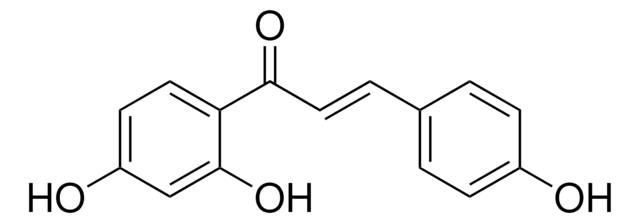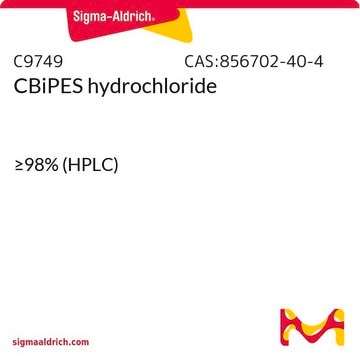Wichtige Dokumente
B178
Butein
solid
Synonym(e):
(2E)- 1-(2,4-Dihydroxyphenyl)-3-(3,4-dihydroxyphenyl)-2-propen-1-on, 2′,3,4,4′-Tetrahydroxychalkon
About This Item
Empfohlene Produkte
Form
solid
Farbe
yellow
Löslichkeit
DMSO: >50 mg/mL
H2O: insoluble
SMILES String
OC1=CC(O)=C(C(/C=C/C2=CC(O)=C(O)C=C2)=O)C=C1
InChI
1S/C15H12O5/c16-10-3-4-11(14(19)8-10)12(17)5-1-9-2-6-13(18)15(20)7-9/h1-8,16,18-20H/b5-1+
InChIKey
AYMYWHCQALZEGT-ORCRQEGFSA-N
Angaben zum Gen
rat ... Alox5(25290)
Suchen Sie nach ähnlichen Produkten? Aufrufen Leitfaden zum Produktvergleich
Allgemeine Beschreibung
Biochem./physiol. Wirkung
Leistungsmerkmale und Vorteile
Vorsicht
Lagerklassenschlüssel
13 - Non Combustible Solids
WGK
WGK 3
Flammpunkt (°F)
Not applicable
Flammpunkt (°C)
Not applicable
Persönliche Schutzausrüstung
Eyeshields, Gloves, type N95 (US)
Hier finden Sie alle aktuellen Versionen:
Besitzen Sie dieses Produkt bereits?
In der Dokumentenbibliothek finden Sie die Dokumentation zu den Produkten, die Sie kürzlich erworben haben.
Artikel
Discover Bioactive Small Molecules for Kinase Phosphatase Biology
Unser Team von Wissenschaftlern verfügt über Erfahrung in allen Forschungsbereichen einschließlich Life Science, Materialwissenschaften, chemischer Synthese, Chromatographie, Analytik und vielen mehr..
Setzen Sie sich mit dem technischen Dienst in Verbindung.





![[Arg8]-Vasopressin solution Grade VI (synthetic), ~100 IU/mL in 0.9% NaCl](/deepweb/assets/sigmaaldrich/product/structures/326/242/dede8c26-cf73-4a28-a5d9-1d57c673cf0e/640/dede8c26-cf73-4a28-a5d9-1d57c673cf0e.png)


